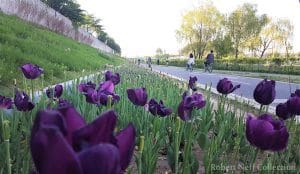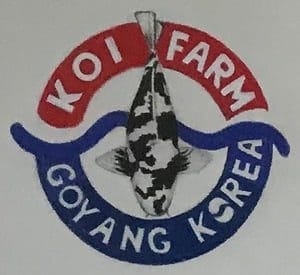ロバート・ネフ著
既報韓国タイムズ
特集写真1900年頃、ソウルのエンバリー夫人と庭。.

19世紀末から20世紀初頭にかけてのソウルの描写は、牛やポニーや人々でごった返す通りや、下水道に落ちたり人や獣の排泄物に足を踏み入れたりするのを避けようとする人々や、煙が充満した空気に漂っているような悪臭に対する不満でいっぱいだった。こうした記述には真実もあったかもしれないが、より客観的な観察者、つまりポジティブなことに目を(鼻を)開こうとする人たちによる、非常にポジティブな記述もあった:
“「韓国は)ほとんど百合の国と呼べるかもしれない。.
スミレ、エグランタイン、バラ、白と赤、ライラック、シャクナゲなど、他の花も同じように咲き乱れ、果樹園では桃や梨の花が大地を栄光と美で満たす。雪が降っても、また雪が降っても、四季折々の花が咲き乱れる。丘や谷は、雪のような白から深いオレンジまで、さまざまな色合いのツツジで彩られる。ある植物学者は、ソウル近郊の丘陵地帯を午後に散策して、47種類の花束を持ち帰った。”
庭の香りに喜びを。.
ソウルの “腐臭 ”と下水道に不満を持つ人々がいる一方で、この作家は春の香りに喜びを見出していた:「すべての花が甘い香りを漂わせているわけではないが、山の高みから吹いてくる風を五感に心地よく響かせるには十分だ。特に春には、風はしばしば香水を携えてやってきて、爽やかさと喜びを与えてくれる。秋になると、香りは色やより丈夫な花に取って代わられる。その中でも、アスターとイヌマキは、緋色、金色、紫色と様々な色合いで丘を覆い尽くす。“

ソウルに住んでいて素晴らしいことのひとつは、市政府が街のあちこちに花畑を植えることに力を入れていることだ。2019年春、自転車レーン沿いに咲く花々。ロバート・ネフ・コレクション
リリアス・アンダーウッドは1880年代半ばに朝鮮に到着し、一時期は朝鮮王妃の西洋医を務めたが、恥ずかしがらずに朝鮮の良い印象も悪い印象も書いている。彼女はこう書いている。「韓国は輝いている......この国は5月と6月に美しい花を咲かせる......(そして)ソウルの周辺はすべて、桃、アンズ、プラム、サクランボ、梨といった絶妙な果物の花で甘い」。丘にはシャクナゲが咲き乱れ、道や塀には可憐な香りを放つ小さなエグランチンが咲き乱れています」。彼女の好きな花のひとつは、春に南漢山の斜面に咲く “処女のような白いスイカズラ ”だった。.

谷間の百合を売るために。.
どうやら、韓国の若い企業家たちが、外国人の野草鑑賞を利用して金儲けができることに気づいたようだ。1899年、Korean Repository(ソウルで発行されていた英字雑誌)はこう書いている:
“「スズランを売り物にした少年たちが外国人の家を訪れている。この美しい花は移植してもほとんど成長しないので、外国人はこの少年たちに購入しないよう勧めるべきである ”と提案されている。”
ソウルに住む欧米人の多くは(ほとんどではないにせよ)、このような文化に親しんできた。 自分たちの庭. .もちろん、菜園や果樹園は、外国人コミュニティが必要とするほとんどのものを供給するために不可欠であった。1897年には、ジェムルポの庭園から500クォート(473リットル)近くのイチゴが収穫された。アメリカ軍の韓国軍顧問だったウィリアム・マッケンタイア・ダイ将軍は、ソウルに広大な果樹園を持ち、バートレットナシ、リンゴ、サクランボ、その他の果物を栽培していた。.
花園はまた、視覚的にも香り的にも美しく、結婚式や洗礼式などの祝いの席に飾られ、19世紀後半のあまりにも一般的な葬儀では遺族の心を高めるのに役立ったため、なくてはならないものだった。.
リリアスは自分の庭をこう表現した:
“「ほぼ一年中、素晴らしい景色だった。春先には、まず黄色いフォルシシアが大量に咲き、次にスミレが咲き、最初の果物の花がいくつか咲き、アーモンドの花や白いライラック、藤の花、ふわふわした緑がかった白のスノーボール、そして玄関の両脇には、親愛なるアメリカの祖母の庭を思い起こさせるような黄色いバラの大きな茂みが2本あった。6月になると、バラは大急ぎで姿を現した。ダマスクローズの生け垣があり、毎日何百本も切られ、家中の鉢や壺や花瓶に詰め込まれ、近所中に送られ、それでも飽きることなく延々と咲き続け、家族もついていけなかった」。”
もちろん、これほどたくさんの花が咲き乱れ、ミツバチも大群をなしていた。“考えることもできないほどのハミング”。”
韓国の小さな庭のいい匂い。.
庭づくりをしていたのは外国人だけではなかった。家庭通信や雑誌、新聞記事のあちこちに、スペースがあればどこでも小さな庭を耕す朝鮮人のことが書かれている。1897年に地方紙に掲載されたこの記事に見られるように、こうした韓国人庭師たちが偏狭な官僚の逆鱗に触れることもあった:
“「この街のタイ・ドゥク・イェップという進取の気性に富んだ男が、自分の屋敷に園芸技術と造園技術を駆使した美しい庭園を造っている。彼は自分の庭に訪問者を受け入れ、数セントの入場料を請求している。しかし、驚いたことに、警察署の次長は昨日、人々の懐を害するという理由で、この商売を止めるよう彼に命じた。”
庭の臭いはお金と仕事を要求する。.
庭を耕すのは簡単ではなかった。多くの労力と資金が必要だった。花や灌木の多くはアメリカやヨーロッパから購入したが、これはかなり危険な傾向があった。ジョン・シル(駐韓アメリカ公使)は、ジェムルポからソウルへの輸送中に、葉巻と一緒に種子の入った箱を盗まれた。彼は10ドル(大金)の報奨金を出したが、葉巻を吸う泥棒は逮捕されなかった。.
種や球根、苗が届いても、腐っていたり、枯れていたりすることもあった。日本の園芸家たちは、ソウルから種子や苗を迅速に、しかも保証付きで提供すれば儲かることに気づいた。この園芸家たちの競争は熾烈を極め、彼らは剣ではなく、地元の英字新聞『インディペンデント』紙で対決した。.

1896年12月15日付の『インディペンデント』紙は、地元関連のコラムでこう報じている:
“「日本の園芸家である高橋氏は、ソウルにいる外国人から花、ファンシーツリー、庭造りの注文を取りたがっている。彼は一流の仕事を保証します」。それ自体は広告ではなかったが、彼のライバルを刺激した。.
その4ヵ月後、山下は新聞広告を出し、「花木でも果樹でも、注文を受けたらすぐにお届けします。また、保証もつけた:“万が一、木が育たなかった場合は無償で交換する”。彼はまた、低価格でおしゃれな庭や花壇を作ることも提案し、参考までに「この街のフランス公使館と日本領事館の庭の施工者」であることを記した。“
Y.高橋は報復した。.
その2週間後、高橋は報復として、「注文を受けたら、さまざまな種類のファンシーツリー、果樹、低木、花を供給します」と宣伝し、価格も控えめにしただけでなく、自分が「農業と園芸の専門家」であることを宣言した。“
その1年後、山下は「ソウルで唯一の花屋であり造園家である」と宣伝した。彼は「日本から輸入した2万5千本の果樹、花木、シェードツリー」と「彼の庭園にある希少で美しい樹木の最も完全なコレクション」を提供した。“
これに対して高橋は、自身の園芸家としての素晴らしい経歴を引き合いに出した:「日本園芸協会会員、帝国農会準会員。そしてこう続けた:「私の庭には、美しいシェードツリー、果樹、低木、花木がたくさんあります。私がお客様のために植え、完璧な満足を与えることを保証します“ と述べた。”
このライバル関係がどうなったかは、1898年12月31日以降、新聞が定期的に発行されなくなったため不明である。おそらく、彼らは長い間、互いに、そして新たな侵入者と戦い続けたのだろう。.
ダイアン・ナーズの貴重な援助と彼女の画像の使用に感謝する。.
ロバート・ネフには、以下のような著書や共著がある、, 朝鮮からの手紙, 西洋から見た韓国 そして 短い出会い. .ロバート・D・ネフ氏はフリーライターで、19世紀後半から20世紀初頭の韓国史を専門とする歴史研究者である。アジア・ソサエティー・コリアのマシュー・フェネルがこの新刊についてインタビューした。. インタビュー
ロバートをフォローする フェイスブック














